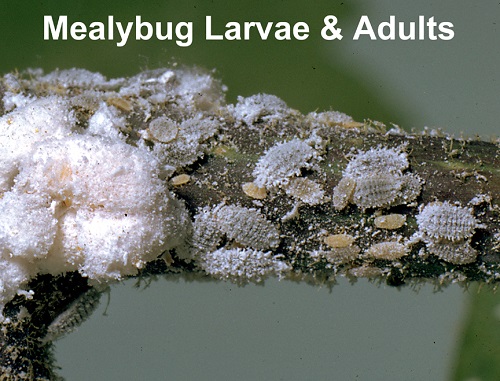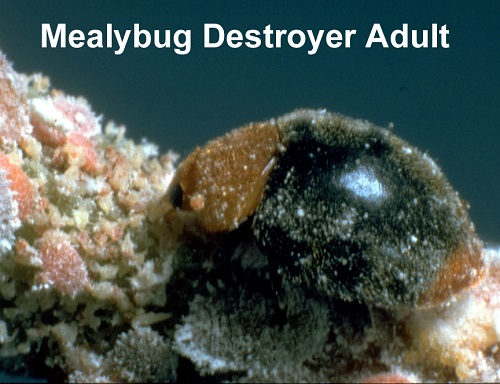While examining the plants in your greenhouse, you might find a few with distorted leaves. The plants might look a little weak, possibly with yellow chlorotic spots on the leaves. When you flip over a leaf, small white cottony clusters appear to be scattered. If you look closely, you can see individual, soft bodied, very slow moving insects. It seems you might have Mealybugs.

Adult female Mealybugs are covered with a fluffy, waxy coating. They tend to gather at a joint of the plant where several branches come together, or down the vein. Adult males look much like a gnat with one pair of wings. With each generation taking about a month, they breed slower than many other insects, but if left unchecked they can slowly and steadily build up to a dense and damaging population. Females can lay up to 600 eggs and within a few weeks the eggs hatch and the larvae crawl out. This is the stage when they spread to new plants, and the stage they are most vulnerable. The larvae find a suitable spot, insert their mouthpart (stylet) into the plant and begin feeding. Mealybugs have a toxic saliva which is partially responsible for distorted leaves and premature leaf drop. They also secret a sticky honeydew while they feed, which sticks to the leaves and can promote sooty mold to grow. Honeydew should be wiped clean with a light soap solution to prevent it from damaging the plant.
Controlling Mealybugs can be difficult due to their waxy coating and the protective areas of the plant where they like to congregate. Repeated applications of horticultural oils and soapy sprays can give some control, but you need to be sure to get the sprays directly on the Mealybugs. General feeding predators like Pirate Bugs, Green Lacewings, and Ladybugs will eat the juvenile Mealybugs. With multiple releases over time, they can get control.
Mealybug Destroyers Cryptolaemus montrouzieri are the best predators for Mealybugs, and they eat both the adult and juvenile stages. These tropical lady beetles are used for rapid knockdown of all above ground species and will also feed on aphids and soft scales. Adult Mealybug Destroyers are approximately 1/8” long, black, with an orange head and “tail”. Both the adults and larvae are predatory. Females lay their eggs among the Mealybugs cottony egg masses (long-tailed Mealybugs give birth to live young which may restrict beetle egg laying). Eggs hatch in 5-6 days at 80°, but it takes longer in cooler temperatures. The young larva sucks out the body contents of Mealybug eggs and young nymphs, passing through four instars before pupating on nearby stems, leaf undersides, or structural supports. These larval stages are covered with a white, waxy material and when small closely resemble their Mealybug prey. Check carefully before pruning off or spraying what appear to be Mealybug-infested shoots to be sure you aren’t removing Cryptolaemus beetle larvae. During the winter months, lower temperatures and shorter day lengths appear to inhibit their activity more than it does the Mealybugs, and control may be inadequate (making repeat releases necessary). Mealybug Destroyers need fairly high Mealybug populations to satisfy its requirements and are best used as a quick knockdown agent for heavy Mealybug infestations.

Like most pests, Mealybugs can cause much damage if left unchecked. Regularly inspect your plants, and at the first sign of trouble use the appropriate controls. It is much easier to control a small outbreak than a full-blown Mealybug metropolis.
Nathan Jackson is the owner of Nature’s Control and Ladybug Indoor Gardens. You can send your specific bug questions to nathan@naturescontrol.com. For more information, to request a catalog, or to find a local distributor, check out Naturescontrol.com or call 541.245.6033.
Related Articles & Free Email Newsletter
3 Simple Ways to Protect Hydroponic Plants from Pests
Azadirachtin and Neem: What is the Difference?
How to Get Rid of Pesky Armadillos


Comment here